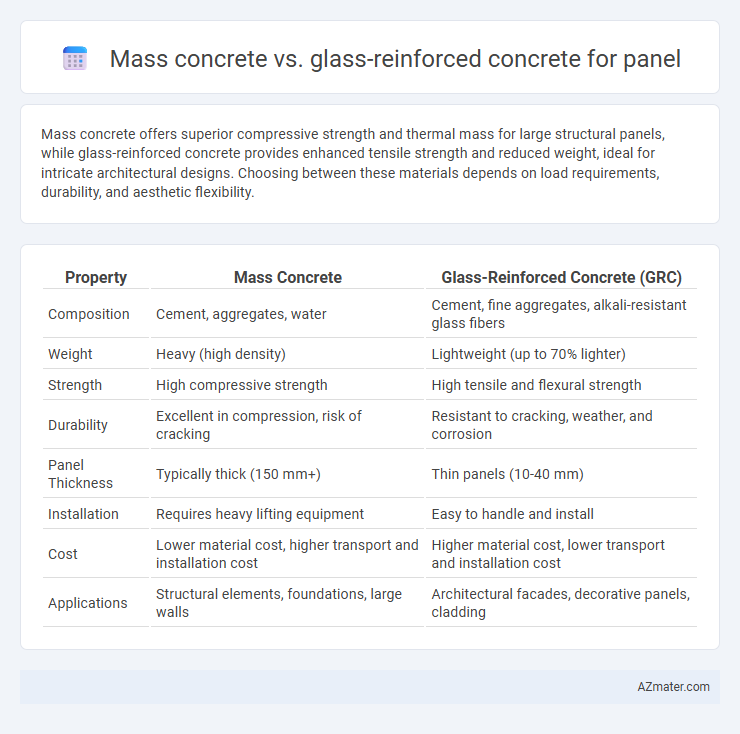Mass concrete offers superior compressive strength and thermal mass for large structural panels, while glass-reinforced concrete provides enhanced tensile strength and reduced weight, ideal for intricate architectural designs. Choosing between these materials depends on load requirements, durability, and aesthetic flexibility.
Table of Comparison
| Property | Mass Concrete | Glass-Reinforced Concrete (GRC) |
|---|---|---|
| Composition | Cement, aggregates, water | Cement, fine aggregates, alkali-resistant glass fibers |
| Weight | Heavy (high density) | Lightweight (up to 70% lighter) |
| Strength | High compressive strength | High tensile and flexural strength |
| Durability | Excellent in compression, risk of cracking | Resistant to cracking, weather, and corrosion |
| Panel Thickness | Typically thick (150 mm+) | Thin panels (10-40 mm) |
| Installation | Requires heavy lifting equipment | Easy to handle and install |
| Cost | Lower material cost, higher transport and installation cost | Higher material cost, lower transport and installation cost |
| Applications | Structural elements, foundations, large walls | Architectural facades, decorative panels, cladding |
Introduction to Mass Concrete and Glass-Reinforced Concrete Panels
Mass concrete panels consist of large, solid concrete sections providing high thermal mass, durability, and structural stability in construction applications. Glass-reinforced concrete (GRC) panels integrate alkali-resistant glass fibers within a cementitious matrix, enhancing tensile strength, reducing weight, and allowing for intricate architectural designs. Both materials serve distinct purposes: mass concrete excels in load-bearing and thermal properties, while GRC is preferred for aesthetic flexibility and lightweight facade solutions.
Composition and Material Characteristics
Mass concrete panels consist primarily of Portland cement, aggregates such as sand and gravel, and water, forming a dense, heavy material with high compressive strength and excellent durability for structural applications. Glass-reinforced concrete (GRC) panels incorporate alkali-resistant glass fibers within a cementitious matrix, enhancing tensile strength, impact resistance, and flexibility while reducing weight compared to traditional mass concrete. The inclusion of glass fibers in GRC improves crack resistance and allows for thinner, more intricate panel designs with superior dimensional stability and reduced shrinkage.
Structural Performance Comparison
Mass concrete panels provide superior compressive strength and excellent load-bearing capacity, making them ideal for heavy structural applications. Glass-reinforced concrete (GRC) panels offer enhanced tensile strength and flexibility due to embedded fiberglass mesh, resulting in better resistance to cracking and impact. The choice between mass concrete and GRC panels depends on specific structural performance requirements, with mass concrete favored for robust stability and GRC preferred for lightweight, high-strength facade systems.
Durability and Lifespan Differences
Mass concrete panels exhibit exceptional durability due to their dense composition and ability to withstand heavy loads, often lasting over 50 years without significant degradation. Glass-reinforced concrete (GRC) panels offer enhanced tensile strength and resistance to cracking due to embedded glass fibers, contributing to a lifespan typically ranging from 30 to 40 years under normal environmental conditions. While mass concrete excels in mass and compressive strength for long-term structural stability, GRC provides superior durability against surface wear, impact damage, and environmental stressors such as freeze-thaw cycles.
Weight and Handling Considerations
Mass concrete panels typically weigh significantly more than glass-reinforced concrete (GRC) panels, resulting in increased transportation and installation challenges. GRC panels offer superior handling benefits due to their lightweight nature, enabling easier maneuverability and reduced labor costs. The reduced weight of GRC also minimizes structural load demands, making it ideal for retrofit or lightweight construction applications.
Thermal Properties and Energy Efficiency
Mass concrete panels exhibit high thermal mass, enabling them to absorb and store heat effectively, which stabilizes indoor temperatures and reduces heating and cooling energy demands. Glass-reinforced concrete (GRC) offers lower thermal mass but provides better insulation properties due to its thinner profile and potential for integrating insulating materials. For energy-efficient building envelopes, mass concrete panels support passive thermal regulation, while GRC panels are often combined with insulation to optimize overall thermal performance.
Installation Methods and Speed
Mass concrete panels require extensive curing time and heavy lifting equipment for installation, resulting in slower construction speeds. Glass-reinforced concrete (GRC) panels are lightweight and can be quickly installed using standard fasteners and minimal labor, significantly accelerating project timelines. The faster setting and reduced handling complexity of GRC panels make them ideal for projects requiring rapid installation and early structural readiness.
Aesthetic and Design Flexibility
Glass-reinforced concrete (GRC) offers exceptional aesthetic and design flexibility compared to traditional mass concrete, enabling intricate shapes, thinner panels, and smooth finishes. Its lightweight nature allows for more innovative facade designs with complex textures and curves that mass concrete's bulkiness and rigidity cannot easily achieve. GRC panels can be colored, textured, and molded with high precision, providing architects greater freedom in creating visually appealing and customized building exteriors.
Environmental Impact and Sustainability
Mass concrete panels have a higher carbon footprint due to the substantial cement content and energy-intensive production process, contributing to increased CO2 emissions and resource depletion. Glass-reinforced concrete (GRC) panels offer enhanced sustainability by incorporating recycled glass fibers that reduce raw material demand and improve durability, leading to longer lifespan and less frequent replacements. The lightweight nature of GRC also decreases transportation emissions, making it an environmentally favorable choice over traditional mass concrete.
Cost Analysis and Long-Term Value
Mass concrete panels typically have lower initial material costs compared to glass-reinforced concrete (GRC), but GRC offers enhanced durability and tensile strength that reduce maintenance and repair expenses over time. The long-term value of GRC panels is attributed to their resistance to cracking, lighter weight facilitating easier installation, and increased lifespan, which can result in lower life-cycle costs despite higher upfront investment. Cost analysis favors mass concrete for budget-conscious projects, while GRC provides superior return on investment in applications requiring longevity and design flexibility.

Infographic: Mass concrete vs Glass-reinforced concrete for Panel
 azmater.com
azmater.com